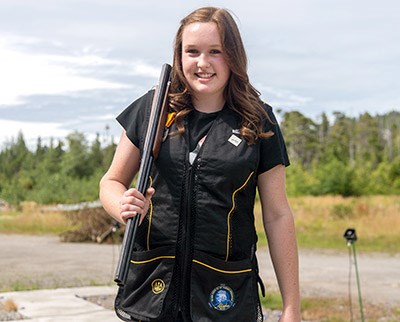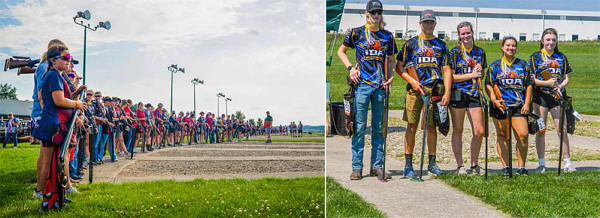

The Importance of
Youth Shooting Sports

(Clockwise from top left: Steve Sisney/AP; John Rucosky/AP; Jean Pieri/AP; Ann Heisenfelt/AP)
By Mark Chesnut. Nov 26, 2024
Article Source
Back when I was in high school, it wasn't uncommon to see shotguns in pickup-truck gun racks in the parking lots of rural schools. Whether the guns were there for a planned dove hunt that evening or just for busting a few clays with buddies down by the river, it never crossed our minds to use those guns for nefarious reasons.
My, how things have changed. The anti-Second Amendment slogan that "kids and guns don't mix," combined with a "mainstream" media that constantly focuses on misuse of guns by youth—which, in actuality, are often gang members fighting for drug turf in big cities—has somewhat turned the tide against youngsters becoming involved with the shooting sports.
That's unfortunate, because the shooting sports teach youth so many valuable lessons that aren't taught as often as they should be today. The shooting sports teach safety, responsibility, courtesy, respect and other aspects of life that will serve youngsters well into the future as they leave high school for college, trade schools or a career.
Also, as with all other aspects of life, youth shooters today are the adult shooters of tomorrow—along with being tomorrow's adult leaders in the ongoing battle to protect the Second Amendment-protected right to keep and bear arms. And that's why supporting and perpetuating youth shooting sports should be at the top of every gun owner's mind.

(Taylor Balkom/AP)
Youth Shooting Programs
While many Americans aren't aware of it, lots of different organizations offer youth shooting programs, many of them through public schools. The American Legion's Junior Shooting Sports Program is a gun-safety education and marksmanship program that encompasses the basic elements of safety, education, enjoyment and competition.
The Youth Shooting Sports Association provides the loan of firearms and archery products to youth shooting groups while donating many other program supplies, such as targets, hearing protection, eye protection and other items as available. Additionally, the National Shooting Sports Foundation (NSSF) established its Scholastic Shooting Sports Foundation in 2007, which they describe as "an educational-athletic organization that exists to introduce school-age youths to the shooting sports and to facilitate their continued involvement by providing, promoting, and perpetuating opportunities to safely and enjoyably participate and compete in a high-quality, team-based sport led by trained adult coaches focused on enhancing the personal growth and development of their athletes."
While these programs introduce youngsters to guns in a safe, responsible manner, they can also lead to college and trade-school scholarships for those who work hard and want to continue with the shooting sports. The National Sporting Clays Association (NSCA) has a scholarship program and presents $5,000 scholarships to four eligible high school seniors each year. Awards are based on shooting participation, scholarship and citizenship.
The National 4-H organization also offers fun, safe training and competition focusing primarily on youth development, helping provide kids with "opportunities to develop life skills, self-worth and conservation ethics." Local 4-H Shooting Sports clubs are open to all youth ages 8 to 18. And each year, 4-H teaches a shooting sport to about a half million boys and girls.
A college student at Texas A&M, Olympic skeet shooter Ryann Phillips began shooting shotguns in third grade through 4-H. "I wanted to show animals when I first got into 4-H," Ryann said in an interview before the 2024 Paris games. "All of my friends showed animals, and I was determined to do it. My mother told me 'no.' So, I looked for another sport and ended up involved in 4-H shotgun and archery. I eventually dropped archery and focused on shotgun."
The rest, as they say, is history. Phillips was thrilled to compete in the Olympics in Paris. And while she didn't come home with a medal, there's little doubt she'll be competing for a spot on the team four years from now.
Incidentally, Olympian Conner Prince, who brought home a silver medal in skeet from Paris, also got his start in the sport of shooting in school through his high school's Spartan Clay Target team. While shooting in high school, Conner was introduced to the discipline of international skeet shooting. He was hooked, and his shooting career began.
"Considering the Olympics only happen once every four years, being one of the two people that get to represent the United States in my discipline is an honor," said Conner prior to the Olympics. "It's honestly a dream come true to be able to represent the greatest country in the world."
The Future Of Farming—And Shooting
The Future Farmers of America (FFA) is also involved in introducing youth to the shooting sports in a safe, responsible manner; in fact, in the largely pro-gun state of Oklahoma, FFA sporting clays—both training and competition—is a really big deal.
Daniel Ballard is the vocational agricultural teacher and FFA leader at Rush Springs High School in rural southwest Oklahoma. The high school has about 140 students, and nearly 30—more than 20% of the school's entire student body—are involved in the clays program.
"Everything's expensive now, and part of the stigma on the FFA side used to be, and still kind of is, that if you were in the FFA, you had to show livestock," said Ballard. "So, this is one way in which kids who aren't showing livestock have an opportunity to be involved. And, even on the collegiate level, there's a lot of opportunity for kids to go on and get scholarships. It's also an incentive for kids to make good grades and to be competitive."
As with most shooting programs, Ballard focuses on introducing firearms to youth who haven't used them before in a safe, responsible manner.
"What I tell my students is that if you've never handled a gun before, my main goal for you is to confidently be able to handle a gun and to not be afraid of it," he said. "I want them to have a comfortable respect for that firearm. Then I can go on and potentially introduce hunting because a lot of kids are interested in hunting but just don't have anyone to teach them about it."
In fact, one of the first things kids in the program are required to do is pass the Oklahoma Department of Wildlife Conservation's online hunter-education program, which is extremely heavy on gun safety.
Along with teaching them safe gun handling, responsibility and shooting skills, Ballard said the program also instills other life skills that they might not have otherwise had the opportunity to learn.
"We're about to go in a couple hours for our first practice of the year, and it's close to 100 degrees," he said. "There's going to be 25 or 30 kids standing out there just waiting to get up there on the line. But there is a lot of sweat equity in it, too. They help set up the course as far as determining where the throwers are and loading the clays in the throwers. And I always send them out at the end of practice to make sure all the trash is picked up. We take care of the course. So, that kind of gets the kids invested in it as well."
Ballard added that not all parents take to the program immediately when they find out their child wants to shoot a gun as part of a school curriculum.
"I know there are programs that have gotten some pushback," he said. "But I think that as long as you make safety and the educational portion the priority, and people know how serious you are about it, then there's an appreciation that comes along. They realize, 'Hey, this is something that my student is obviously interested in. Let's give it a try.'"
NRA And Youth
Of course, the National Rifle Association has long been at the forefront of the youth shooting movement, having been involved in promoting the shooting sports to youth since 1903. And the NRA continues to operate a number of outstanding youth programs including competitions, awards and contests, training and safety courses, scholarships and more.

These images show just a few of the participants in the Scholastic Shooting Sports Foundation's Nationals
Championships. Interest in the shooting sports has been growing in the next generation; in fact, the USA High
SchoolClay Target League has grown to include tens of thousands of students across more than 30 states.
(Left: Tom Davis; right: Maggie Kelch)
The Adventure Camp at the NRA Whittington Center in New Mexico is arguably America's best outdoor youth camp for boys and girls aged 13 to 17. Under direct supervision of staff and trained volunteers, campers learn everything from shooting fundamentals to firearms safety, marksmanship, basic wilderness survival skills and more.
NRA's Youth Hunter Education Challenge (YHEC) provides a fun environment for kids to improve their hunting, marksmanship and safety skills. Through its simulated hunting situations, live-fire exercises, educational and responsibility events, YHEC helps build upon skills learned in basic hunter-education courses and encourages safer, lifelong hunting habits.
Additionally, the NRA's Home Air Gun Program Introduction brings marksmanship activities directly to communities across the country. This guide provides parents, teachers and activity and club leaders with all of the information and guidance they need to create their own BB and air-gun shooting programs.
And who could overlook the Association's Eddie Eagle GunSafe Program, which teaches kids in Pre-K through fourth grade what to do if they ever find a gun. Since 1988, the program has taught more than 32 million youngsters this important message, doubtlessly saving countless lives along the way.
The Battle Against Youth Shooting
Of course, not everyone is excited about the youth shooting sports; in fact, many anti-gun advocates are dead set in their belief that "kids and guns don't mix" at all, and they'll do whatever they can to discourage young shooters in order to ensure guns and shooting aren't passed to the next generation.
The Atlantic magazine described the main focus of this scheme in a 2023 story titled, "The Ad Industry's Plan to Fix America's Gun Crisis."
"As the public face of firearms, the NRA makes for a compelling enemy," the article stated. It also quoted Tufts University Professor Michael Siegel as saying: "Thirty years ago, the tobacco industry was like the NRA." The gist is that gun owners and gunmakers should be forced by law to pay for public-service advertisements warning about the danger of their products, like tobacco companies were once forced to do.
"To break new ground, gun-violence-prevention advocates want to reframe the story of guns in America by lifting a page from the anti-smoking playbook," said the article. "In 1998, the four largest cigarette manufacturers signed the Master Settlement Agreement, which was like Big Tobacco's Treaty of Versailles. It required them to amend their marketing practices and make annual payments to the states to compensate for the medical costs incurred by smoking-related illnesses. Those concessions hobbled profitability—up to a point. But tobacco's steep cultural decline can be attributed, in part, to a specific provision that allocated millions of dollars to a national PSA campaign aimed at dissuading new smokers."
The idea is for gunmakers to be forced to make advertisements warning kids not to learn to shoot skeet, trap or whatever shooting sport they are interested in. Of course, it's based on one main fallacy: that guns and tobacco are similar. Unlike tobacco, however, guns are not dangerous unless used unsafely or by criminals; in fact, considering the million-plus defensive uses of firearms each year, they are very beneficial to the law-abiding portion of society.
To keep kids from becoming interested in the shooting sports or expanding an already developed interest, in 2022, California lawmakers passed AB 2571, which banned advertising or marketing firearms or ammunition in a way that is "attractive to minors." The law allowed for up to $25,000 fine per violation—numbers most organizations simply couldn't risk getting socked with for communications with young shooters that the state might deem inappropriate.
One youth shooter directly affected was Lola Fitzgerald, who was a four-time Skeet All-American, three-time Junior World Champion and four-time California State Lady Champion in skeet shooting. Her family had high hopes that her shooting would land her a college scholarship, but that all came crashing down when AB 2571 was passed.v
"Communications that we had with recruiting colleges, such as Trinity, Hillsdale, Purdue, Jacksonville University and TCU have stopped because they are unable to communicate with youth in California regarding their shooting teams and opportunities," Lola's father, Jay Fitzgerald, posted on social media in July 2022. "[This is] because of the reasonable fear that if they do advertise, market or otherwise communicate with her (and other minors in California), they will expose themselves to substantial civil liability under AB 2571."
Fitzgerald also said that emails from the National Skeet Shooting Association ceased, as did communication from many other organizations, such as USA Shooting. Plus, Lola was no longer able to log into sites to see future tournaments and standings of shooters as they compete.

The popularity of the shooting sports have continued despite efforts by some to outlaw them. (NRA)
"All publications have stopped coming to my daughter, and coaches are canceling training clinics that she would usually attend," he said. "We are unsure even if we fly our daughter out of state to train whether the coaches would be in violation of the law because our daughter is a resident of California."
In September 2022, following an NRA-backed lawsuit, an amendment to AB 2571 helped, but promoting participation in youth shooting sports in the Golden State is still much more difficult than in other parts of the country.
The Biden Administration on the Attack
President Joe Biden (D) tried to wreck youth shooting programs in schools under the auspices of the Bipartisan Safer Communities Act (BSCA) passed in 2023.
The NRA repeatedly warned lawmakers that the law was a wolf in sheep's clothing; in fact, NRA-ILA warned that the measure could "be abused to restrict lawful gun purchases, infringe upon the rights of law-abiding Americans and use federal dollars to fund gun control measures being adopted by state and local politicians."
As NRA-ILA also explained, the bill "leaves too much discretion in the hands of government officials and also contains undefined and overbroad provisions—inviting interference with our constitutional freedoms."
The legislation passed anyway, and NRA-ILA was exactly right. In August 2023, the Department of Education used the BSCA to launch a battle against the very future of hunting and shooting by blocking federal funding earmarked under the Elementary and Secondary Education Act of 1965 for schools with hunting and archery programs. Republicans in Congress, including some who had voted for the BSCA, quickly scolded the administration on the withholding of funds.
Still, many schools were faced with the critical decision of trying to figure out how to continue with hunting and shooting programs that could no longer receive funding from the federal government. By September, the House, in a 424-1 vote, approved HR 5110, the Protecting Hunting Heritage and Education Act that would end the abuse of schools under the BSCA. The Senate immediately fast-tracked the measure, passing it by unanimous consent. Biden, without making a statement about the legislation, signed the bipartisan measure.
In the end, the battle to protect youth shooting sports is actually a battle to protect the future of shooting, gun ownership and the Second Amendment. Proving that in most cases "kids and guns do mix" is a job we must all take to heart.
With some "soccer moms" becoming "sporting clays moms" and "skeet moms" in many parts of the country, youth shooting sports offer the opportunity to not only change kids' lives by introducing them to guns and shooting, but also change parents', grandparents' and other observers' minds about gun ownership when they see their kids or grandkids step up to the line and break a clay or hit a bullseye.
The NRA's longtime effort to preserve the Second Amendment has met with lots of success over the years, but the battle will be an ongoing one for as long as there are those on the other side set on curtailing and infringing private firearm ownership. The youth we fight for today will soon be the adults fighting for the youth of tomorrow.
NRA Resources for Youth Shooting Sports
The NRA has resources, programs and training to assist youth organizations, such as Boy Scout troops, Royal Ranger outposts, American Legion posts, JROTC units, 4-H clubs, FFA chapters, commercial summer camps and U.S. Jaycee chapters. If your organization or club offers gun safety or shooting sports programs, NRA can help!
Check out: explore.nra.org/programs/national-youth-shooting-sports-cooperative-program, competitions.nra.org, nraday.nra.org, yhec.nra.org, ssusa.org and other NRA sites for resources to help competitors, instructors and those who want to get involved in the shooting sports.
![]()
























